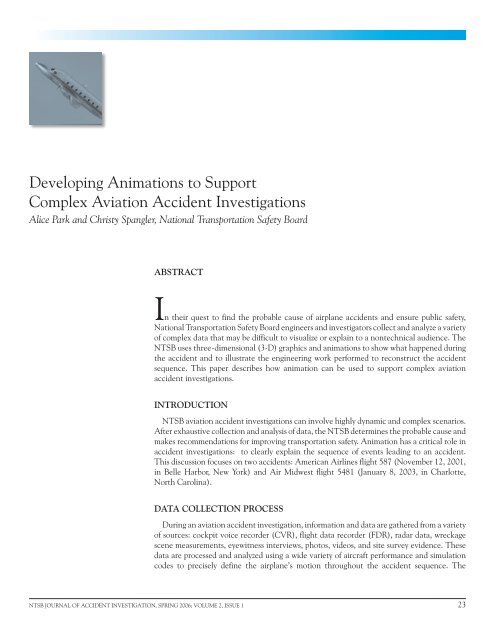Journal of Accident Investigation
Journal of Accident Investigation
Journal of Accident Investigation
Create successful ePaper yourself
Turn your PDF publications into a flip-book with our unique Google optimized e-Paper software.
Developing Animations to Support<br />
Complex Aviation <strong>Accident</strong> <strong>Investigation</strong>s<br />
Alice Park and Christy Spangler, National Transportation Safety Board<br />
ABSTRACT<br />
I n their quest to find the probable cause <strong>of</strong> airplane accidents and ensure public safety,<br />
National Transportation Safety Board engineers and investigators collect and analyze a variety<br />
<strong>of</strong> complex data that may be difficult to visualize or explain to a nontechnical audience. The<br />
NTSB uses three-dimensional (3-D) graphics and animations to show what happened during<br />
the accident and to illustrate the engineering work performed to reconstruct the accident<br />
sequence. This paper describes how animation can be used to support complex aviation<br />
accident investigations.<br />
INTRODUCTION<br />
NTSB aviation accident investigations can involve highly dynamic and complex scenarios.<br />
After exhaustive collection and analysis <strong>of</strong> data, the NTSB determines the probable cause and<br />
makes recommendations for improving transportation safety. Animation has a critical role in<br />
accident investigations: to clearly explain the sequence <strong>of</strong> events leading to an accident.<br />
This discussion focuses on two accidents: American Airlines flight 87 (November 12, 2001,<br />
in Belle Harbor, New York) and Air Midwest flight 481 (January 8, 2003, in Charlotte,<br />
North Carolina).<br />
DATA COLLECTION PROCESS<br />
During an aviation accident investigation, information and data are gathered from a variety<br />
<strong>of</strong> sources: cockpit voice recorder (CVR), flight data recorder (FDR), radar data, wreckage<br />
scene measurements, eyewitness interviews, photos, videos, and site survey evidence. These<br />
data are processed and analyzed using a wide variety <strong>of</strong> aircraft performance and simulation<br />
codes to precisely define the airplane’s motion throughout the accident sequence. The<br />
NTSB JOURNAL OF ACCIDENT INVESTIGATION, SPRING 2006; VOLUME 2, ISSUE 1 23
















